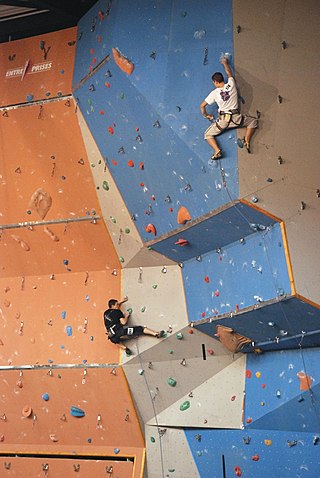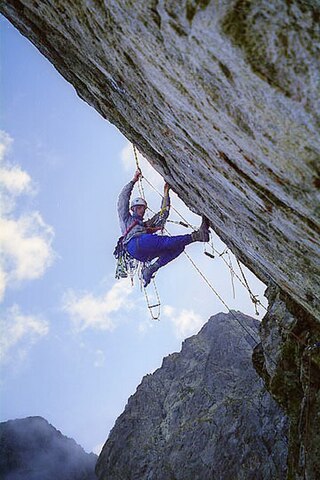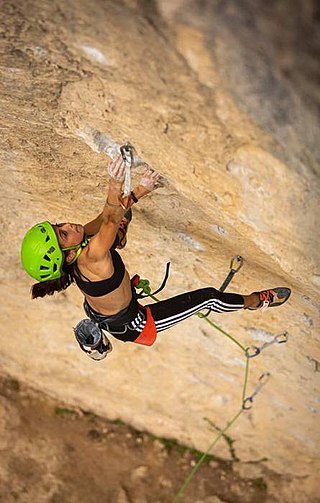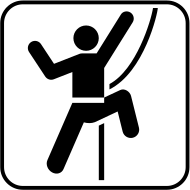
Bouldering is a form of free climbing that is performed on small rock formations or artificial rock walls without the use of ropes or harnesses. While bouldering can be done without any equipment, most climbers use climbing shoes to help secure footholds, chalk to keep their hands dry and to provide a firmer grip, and bouldering mats to prevent injuries from falls. Unlike free solo climbing, which is also performed without ropes, bouldering problems are usually less than six metres (20 ft) tall. Traverses, which are a form of boulder problem, require the climber to climb horizontally from one end to another. Artificial climbing walls allow boulderers to climb indoors in areas without natural boulders. In addition, bouldering competitions take place in both indoor and outdoor settings.

A climbing wall is an artificially constructed wall with grips for hands and feet, usually used for indoor climbing, but sometimes located outdoors. Some are brick or wooden constructions, but on most modern walls, the material most often used is a thick multiplex board with holes drilled into it. Recently, manufactured steel and aluminium have also been used. The wall may have places to attach belay ropes, but may also be used to practice lead climbing or bouldering.

In rock climbing, mountaineering, and other climbing disciplines, climbers give a grade to a climbing route or boulder problem, intended to describe concisely the difficulty and danger of climbing it. Different types of climbing each have their own grading systems, and many nationalities developed their own, distinctive grading systems.
Climbing protection are the mechanical devices and pieces of equipment used by climbers to reduce the risks, and the effects, of a fall to the climber while rock climbing or ice climbing. It includes such items as nylon webbing and metal nuts, cams, bolts, and pitons.

A climbing route is a path by which a climber reaches the top of a mountain, a rock face or obstacle, or an ice-covered face or obstacle. The details of a climbing route are recorded in a climbing guidebook and/or in an online climbing route database and will include elements such as the type of climbing route, the difficulty grade of the route and any risk or commitment grade, the length and number of pitches of the route, and the type of climbing equipment needed to complete the route.

Glossary of climbing terms relates to rock climbing, mountaineering, and to ice climbing.

Rock-climbing equipment requires a range of specialized sports equipment, for training, for aid climbing, and for free climbing. Developments in rock-climbing equipment played an important role in the history of rock climbing, enabling climbers to ascend more difficult climbing routes safely, and materially improving the strength, conditioning, and ability of climbers.

Solo climbing, or soloing, is a style of climbing in which the climber climbs alone, without the assistance of a belayer. By its very nature, it presents a higher degree of risk to the climber, and in some cases, is considered extremely high risk. Note that the use of the term "solo climbing" is generally separate from the action of bouldering, which is itself a form of solo climbing, but with less serious consequences in the case of a fall.

Aid climbing is a form of rock climbing that uses mechanical devices and equipment, such as aiders, for upward momentum. Aid climbing is the opposite of free climbing, which only uses mechanical equipment for protection, but not to assist in upward momentum. "Traditional aid climbing" involves hammering in permanently fixed pitons and bolts, into which aiders are clipped, whereas "clean aid climbing" avoids hammering, and only uses removable placements.

Sport climbing is a type of free climbing in rock climbing where the lead climber clips into pre-drilled permanent bolts for their protection while ascending a route. Sport climbing differs from the riskier traditional climbing where the lead climber has to insert temporary protection equipment while ascending.

Belaying is a variety of techniques climbers use to create friction within a climbing system, particularly on a climbing rope, so that a falling climber does not fall very far. A climbing partner typically applies tension at the other end of the rope whenever the climber is not moving, and removes the tension from the rope whenever the climber needs more rope to continue climbing.

Lead climbing is a technique in rock climbing where the lead climber clips their rope to the climbing protection as they ascend the climbing route, while their second remains at the base of the route belaying the rope to protect the lead climber in the event that they fall. The term is used to distinguish between the two roles, and the greater effort and increased risk, of the role of the lead climber.

Rock climbing is a sport in which participants climb up, across, or down natural rock formations or indoor climbing walls. The goal is to reach the summit of a formation or the endpoint of a usually pre-defined route without falling. Rock climbing is a physically and mentally demanding sport, one that often tests a climber's strength, endurance, agility and balance along with mental control. Knowledge of proper climbing techniques and the use of specialized climbing equipment is crucial for the safe completion of routes.

Multi-pitch climbing is a type of climbing that typically takes place on routes that are more than a single rope length in height, and thus where the lead climber cannot complete the climb as a single pitch. Where the number of pitches exceeds 6–10, it can become big wall climbing, or where the pitches are in a mixed rock and ice mountain environment, it can become alpine climbing. Multi-pitch rock climbs can come in traditional, sport, and aid formats. Climbers have also free soloed multi-pitch routes.
In rock climbing, an anchor can be any device or method for attaching a climber, a rope, or a load above or onto a climbing surface—typically rock, ice, steep dirt, or a building—either permanently or temporarily. The intention of an anchor is case-specific but is usually for fall protection, primarily fall arrest and fall restraint. Climbing anchors are also used for hoisting, holding static loads, or redirecting a rope.

Competition climbing is a form of regulated rock climbing competition held indoors on purpose-built artificial climbing walls, with earlier versions held on external natural rock surfaces. The three competition climbing disciplines are lead climbing, bouldering, and speed climbing. The result of multiple disciplines can be used in a "combined" format to determine an all-round winner. Competition climbing is sometimes called "sport climbing", which is the type of lead climbing performed in competition climbing.

An ice screw is a threaded tubular screw used as a running belay or anchor by climbers on steep ice surface such as steep waterfall ice or alpine ice during ice climbing or crevasse rescue, to hold the climber in the event of a fall, and at belays as anchor points.

A belay device is a mechanical piece of climbing equipment used to control a rope during belaying. It is designed to improve belay safety for the climber by allowing the belayer to manage their duties with minimal physical effort. With the right belay device, a small, weak climber can easily arrest the fall of a much heavier partner. Belay devices act as a friction brake, so that when a climber falls with any slack in the rope, the fall is brought to a stop.

Big wall climbing is a form of rock climbing that takes place on long multi-pitch routes that normally require a full day, if not several days, to ascend. Big wall routes are typically sustained and exposed, where the climbers remain suspended from the rock face, even sleeping hanging from the face, with limited options to sit down or escape unless they abseil back down the whole route. It is therefore a physically and mentally demanding form of climbing.

A climbing gym is a gym dedicated to indoor climbing. Climbing gyms have climbing walls that can be used for leading, top roping, and bouldering. They sometimes offer training equipment to improve technique, strength, and endurance.




















